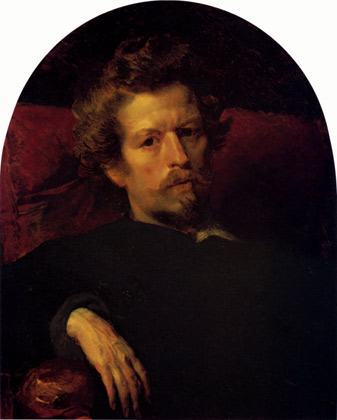The directory «Artists»
Brulloff Karl Petrovitch
(1799—1852)

He was called by his contemporaries The Great Karl. His masterpiece The Last Day of Pompeii (1830-1833), an enormous composition painted in Italy in 1830-1833, was a real triumph. Italian critics compared Brulloff to the greatest artists of the past, such as Rubens, Rembrandt, and Van Dyke. At the age of 33 Brulloff gained European fame.
Karl Brulloff (Brullo until 1822, when the family name was changed according to Russian pronunciation) was born in 1799 in St. Petersburg into the family of painters: his great grand-father, his grand-father, his father and his two elder brothers Fedor and Alexander were artists. In 1809-1821, Karl studied art in the Academy of Arts in St. Petersburg. One of his early notable pictures Narcissus (1819), created while studying in the Academy, was implemented in the principles of Classicism, which he was taught. Brulloff graduated from the Academy with honors and was sent along with his brother Alexander to Italy to study art as pensioners of the Society for the Promotion of Artists.
He spent in Italy 13 years, studying art of the ancient Italy, copying the antiques in the museums and making a lot of drawings in the streets of Rome. He painted portraits, both ceremonial and intimate ones, and created series of genre scenes of everyday Roman life. The most important of his genre works was Italian Midday (1827). In Italy Brulloff created over 120 portraits in various techniques. Among them are portraits of the Russian aristocracy, residing in Italy, as well as painters, sculptors, writers, etc., and also Italian statesmen and artists. Among the most notable are portraits of Grand Duchess Elena Pavlovna, Prince G. Gagarin, Countess Yu. Samoilova and her foster children, Princess Z. Volkonskaya, Bruloff's brother Alexander, A. Lvov, Architect K. A. Ton, Italian singers Juditta Pasta and Fanny Persiani-Tacinardi and many others. He also painted several self-portraits, some of them were commissioned by the Uffizi Gallery.
One of the requirements of the Society for the Promotion of Artists for its pensioners was to paint a big historical picture. In 1827, Brulloff visited the excavation site of Pompeii, a town destroyed and buried in hot lava during an eruption of Volcano Vesuvius on August 24, 79 A.D. Brulloff was deeply impressed when he saw the town, preserved under the layer of lava, where a life was suddenly stopped. Six years were to pass between the first conception and its materialization. After the first sketches have been done, Brulloff began studying the materials of the excavations and historical documents, such as the letters of Pliny the Younger, who was an eye-witness of the event. It is believed, that the son persuading his mother to come with him in the right part of the picture is Pliny with his mother. The picture The Last Day of Pompeii (1830-1833) was a huge success in Italy. It was also exhibited in Louvre, Paris.
In 1835, Brulloff returned to Russia. In the years that followed he painted mostly portraits. Among the best portraits of this period are those of Author Nestor Kukolnic, Count A. A. Perovsky (the Author Anton Pogorelsky) and his nephew future Poet and Playwright Alexey Tolstoy, Author A. N. Strugovshchikov, Princess Ye. P. Saltykova, Countess Yu. P. Samoylova.
In 1849, Brulloff had to come to Italy again for his deteriorating health, which was due to his unhappy marriage and his hard work on the paintings of St. Isaac's Cathedral in St. Petersburg, which he was unable to finish. He spent one year on Madeira, the climate of each was believed to be beneficial for the patients with heart diseases, and his last two years in Rome. He created several excellent works during these years, including portraits of members of Tittoni family, with whom he was very close. He died in Rome on June 23, 1852.
Russia, 2006,  Birth Bicentenary of admiral Kornilov
Birth Bicentenary of admiral Kornilov